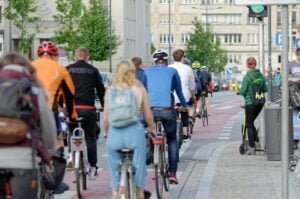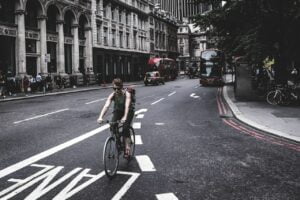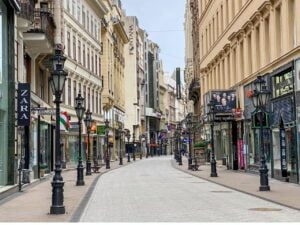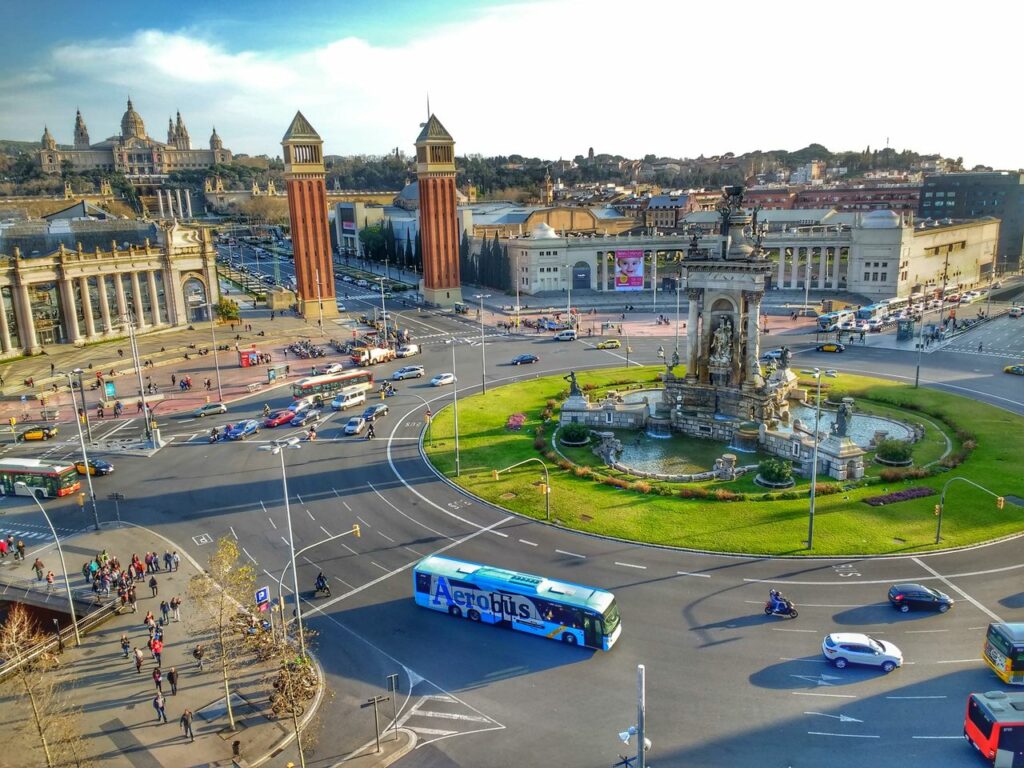Keeping Things Moving: A post lockdown mobility landscape
Cities and regions have acted quickly to adapt urban mobility to the challenges of COVID-19. In this article, Jamie Wylie and Karen Vancluysen explore how cities responded during lockdown, what can be expected for urban mobility in the post-lockdown phase, and how we can capitalise on the opportunities of this crisis over the longer term
Urban mobility has faced an unprecedented challenge from COVID-19. Almost overnight, local authorities have had to adapt to entirely new conditions and restrictions as governments tried to keep people safe.

To help our members and other interested cities and regions, we have been collecting examples of how local authorities in Europe and further afield are keeping things moving despite the Covid-19 crisis.
This has changed urban mobility as we know it: deserted streets, empty public transport services, once vibrant urban spaces now silent. Cities and regions have faced, and will continue to face, huge challenges in adapting mobility to ever-changing conditions. However, in the face of this adversity, the resilience and ingenuity shown by cities and regions in our network and beyond has been nothing short of inspiring. Local authorities have acted swiftly and decisively to protect citizens and ensure that restrictions to prevent the spread of COVID-19 did not damage essential and sustainable mobility services. At POLIS we’ve been working to support our members during this challenging time. Our Post-Lockdown Mobility webinar series has showcased how cities and regions across Europe are adapting mobility to keep people safe and ensure that sustainable urban mobility is prioritised both during and after the lockdown phase. Our Keeping Things Moving page has provided inspiration and insight into how cities have reacted and adapted to COVID-19, highlighting best practices and innovations from across the world.
The immediate priority for local authorities lies in responding to this crisis, keeping people safe and trying to restore mobility to aid the economic and social recovery of cities and regions. However, it is clear that this situation has presented a huge opportunity not just to rethink how people move around, but also to change urban mobility - and our cities - for the better and for good.
How cities responded during COVID-19
Perhaps the biggest challenge for urban mobility during lockdown was the impact on public transport. With travel restrictions in place, demand for public transport was significantly reduced, with ridership falling as much as 95% in some cases. Local authorities responded by restricting operations to reduced frequencies and operating hours. For those remaining journeys that needed to be made on public transport, local authorities and operators implemented strict safety standards to protect both passengers and staff. A survey of our members highlighted that cities had implemented measures such as isolating drivers from passengers, the suspension of cash payments, and mandatory social distancing on carriages.
Many cities sought to help essential workers get around safely and easily, such as in Madrid, where a free bus service was launched for hospital staff. With public transport restricted, active travel has come to the forefront of urban mobility. Cities from Berlin to Bogotá to Budapest created new bike lanes to give people space when cycling, and widened sidewalks to help people keep a safe distance and protected from car traffic. Shared mobility endured a challenging time during lockdown, with many companies suspending services and suffering challenging financial conditions. However, some have risen to the challenge during the crisis, offering free or discounted services for essential workers and supporting restaurants with home deliveries.
How cities are coming out of COVID-19

Improved cycling infrastructure is just one way cities are responding
As Europe moves out of lockdown and restrictions ease, many cities are looking to the future of mobility. With public transport set to be restricted for the months ahead or working towards rebuilding trust, many are fearing a consequent rise in car use as people seek alternatives. In response, a growing number of local authorities are setting out plans to put people before vehicles and make walking and cycling the norm for everyday urban journeys. There has been an explosion of cities re-allocating road space for active travel, including measures such as pavement widenings, safe cycle lanes, street closures and lower speed limits in city centres. In our Post-Lockdown Mobility webinar series we heard how Brussels implementing transformational plans to prioritise walking and cycling, with expanded cycle networks, lower speed limits and pedestrian priority measures. We also heard about London’s Streetspace Plan, an ambitious strategy to create safe cycle and walking access throughout the city and reduce the dominance of cars, including major changes to vehicle access in the city centre. With many more following suit, we could be set to see a transformation of cities across Europe.
As travel restrictions begin to ease, cities are preparing for a partial return of people to public transport. In response, new measures are being implemented to ensure safe and hygienic travel on public transport. Our Post-Lockdown Mobility webinars demonstrated how Rome and Barcelona (and many others) are adapting public transport now that travel restrictions have lifted, with face masks, gloves and strict social distancing rules in place. Barcelona, alongside cities such as Edinburgh, are also prioritising road space for public transport, for example through additional bus lanes, helping to recover passenger numbers by ensuring reliable and convenient services. However, with public transport only able to provide for a fraction of the demand, many cities are asking how the gap will be filled for these journeys. Yes, increases in walking and cycling will be able to take a large number of these journeys, but other solutions, such as shared mobility, will need to be investigated to ensure that unwanted large increases in car traffic are avoided.
Moving forward
In spite of the huge challenges faced from COVID-19, this is an opportunity like no other to rethink urban mobility. As we look forward, several key opportunities are presented for cities and regions to use this as a chance to put sustainable urban mobility first.
Behavioural change
Behavioural change experts have always told us that life-changing moments, such as getting married, moving house, having children, offer the best opportunity to make permanent changes in deep-rooted behavioural habits, such as mobility choices. With COVID-19 having a major impact on people’s daily lives and mindsets, the current crisis could be such a trigger for long-term behavioural change. Many people have discovered cycling as an alternative to public transport or private car use, for daily journeys or simply as a means of keeping physically active. Making this temporary behaviour permanent would be truly transformative for urban mobility. In our Post-Lockdown Mobility webinar on Milan, we heard how the average commute in the Italian city is less than 5km. This is undoubtedly the case for many cities across Europe. With actions to improve conditions for cycling and walking, there is real potential to lock in this behaviour change. Furthermore, with home-working becoming commonplace during COVID-19, there is also an opportunity to make this a bigger part of the working week, thus reducing travel demand, particularly at peak hours in mornings and evenings.

Cyclist in London
Piloting and sandboxing
Trialling and testing new measures can work well in gaining support from the public. Giving people a taste of something they may initially be opposed to can help to address concerns and demonstrate the value of change. This was made clear in the case of Stockholm’s congestion charge scheme, which after an initial trial period was accepted by citizens in a public referendum. Taking space away from cars is almost always a controversial decision, and with the short-term cycles of politics, politicians understandably fear the impact on the next election. But in both the lockdown and post-lockdown phases, many people have realised the benefits of reducing the presence of cars in urban spaces. Many have experienced the joy of cycling, of streets without congestion, of breathing cleaner air. Giving people a taste of a better future for cities has created a real public will for temporary measures to become permanent.
An integrated multimodal urban mobility ecosystem

The empty streets of Budapest
An integrated multimodal urban mobility ecosystem will be needed now more than ever. We need different sustainable modes to support, reinforce and complement each other. To realise the full potential of a truly integrated mobility system, closer cooperation between public and private mobility service providers will be required. Public transport will remain the backbone of cities, but operators are going to face a challenging time and will have to deal with reduced capacity (and revenue) for a while. This is the moment for public transport and shared mobility to join forces. There is real potential for shared mobility to take some pressure away from public transport and to spread capacity by shifting some travellers to shared bikes, e-bikes and e-scooters.
Whilst shared mobility providers have endured huge challenges in recent months, this crisis has also offered opportunities for these services to prove their value to cities. Operators have been offering free rides for essential workers and often partnered with cities to make this happen. For those who pulled out of the market for commercial reasons, this is a huge missed opportunity. If these services can prove to cities that they have a meaningful role to play, then cities should consider how new and closer partnerships with shared mobility operators can be created, and whether options such as waiving fees for e-bikes and e-scooters or partially subsidised trips for shared mobility could make integrated sustainable mobility a reality.
Looking to the future
There is huge potential for change in urban mobility, but this will not materialise on its own. We must take initiative, work together and act now to ensure that these opportunities are realised. Cities and regions have shown they can act fast in times of extreme emergency. Public transport has shown, once more, that it is an essential service that we all rely on. For active travel, it has become even more urgent to provide safe space to support walking and cycling. Our cities will now show how resilient they are and how they can bounce back from this unprecedented situation, but they cannot do it alone. We need the higher levels of government - national and European - to support and empower our cities and regions and ensure this crisis is turned into a long-lasting opportunity for sustainable, integrated urban mobility.
Authors: Jamie Wylie is Project Coordinator at the Solar Impulse Foundation, Karen Vancluysen is Secretary General of POLIS Network
